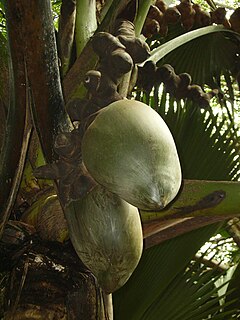
Lodoicea, commonly known as the sea coconut, coco de mer, or double coconut, is a monotypic genus in the palm family. The sole species, Lodoicea maldivica, is endemic to the islands of Praslin and Curieuse in the Seychelles. It has the biggest seed in a plant. It formerly also was found on the small islets of St Pierre, Chauve-Souris, and Ile Ronde, all located near Praslin, but had become extinct there for a time until recently reintroduced. The name of the genus, Lodoicea, may be derived from Lodoicus, one Latinised form of Louis, in honour of King Louis XV of France. Other sources say that Lodoicea is from Laodice, the daughter of Priam and Hecuba.

Magnolia macrophylla, the bigleaf magnolia, is a deciduous magnolia native to the southeastern United States and eastern Mexico. This species boasts the largest simple leaf and single flower of any native plant in North America.

Elodea canadensis is a perennial aquatic plant, or submergent macrophyte, native to most of North America. It has been introduced widely to regions outside its native range and was first recorded from the British Isles in about 1836.
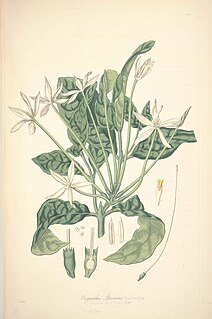
Oxyanthus is a genus of plant in family Rubiaceae. It contains the following species :

Aeonium haworthii, also known as Haworth's aeonium or pinwheel, is a species of succulent flowering plant in the family Crassulaceae. It is grown as a houseplant in temperate regions. It has gained the Royal Horticultural Society's Award of Garden Merit, as has the cultivar 'Variegatum'.

Baccharis malibuensis is a rare California species of shrubs in the family Asteraceae known by the common name Malibu baccharis.
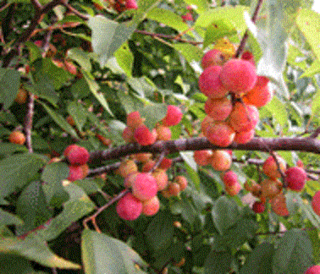
Prunus rivularis, known variously by the common names creek plum, hog plum, or wild-goose plum is a thicket-forming shrub. It prefers calcareous clay soil or limestone-based woodland soils. This deciduous plant belongs to the rose family, Rosaceae, and is found mainly in the central United States. It is a shrub consisting of slender stems with umbel clusters of white blossoms. The fruit is a drupe that resembles a large berry; though it has a bitter taste, it serves as a source of food for birds and other wildlife. "Prunus" is Latin for plum, whereas "rivularis" means being near a stream.

Ferocactus emoryi, known commonly as Emory's barrel cactus, Coville's barrel cactus and traveler's friend, is a barrel cactus in the genus Ferocactus.

Aeonium dodrantale is a species of tree houseleek in the family Crassulaceae.
Salacca affinis, also known as red salak, red snakefruit salak, red snakefruit, buah ridan salak, buah ridan, linsum, salak hutan, buah manau, kelubi, buah rotan, and ridan, is a flowering shrub in the family Arecaceae. The specific epithet (affinis) comes from Latin "ad finis", meaning "at the boundary", and refers to its resemblance with the congener species Salacca zalacca.
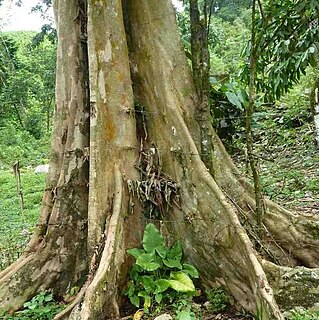
Licania platypus, also known as sun sapote, sansapote, sonzapote, sunzapote, sungano, zapote cabelludo, sapote, sangre, zapote amarillo, zapote borracho, zapote cabello, zapote de mico, zapote de mono, mesonsapote, mezonzapote, cabeza de mico, caca de nino, sonza, sunza, zunza, chaute jolobob, urraco, chupa, and monkey apple, is a flowering tree in the family Chrysobalanaceae.
Calamus erectus, also known as viagra palm and locally as tynriew, tara, and zhi li sheng teng, is a flowering shrub in the family Arecaceae. The specific epithet (erectus) refers to the plant's habit of growing straight rather than creeping or climbing like many species of the genus Calamus.

Litsea garciae, also known as engkala, kalangkala, kangkala, medang, pangalaban, ta'ang, malai, wuru lilin, kelimah, bua talal, kelime, kelimie, bua' vengolobon, wi lahal, kelima, mali, beva' mali, kayu mali, malei, pengalaban, pengolaban, kupa, pipi, bagnolo, bangulo, lan yu mu jiang zi, lan yu mu, buah tebuluh, tebulus, pong labon, and Borneo avocado, is a flowering tree in the family Lauraceae.
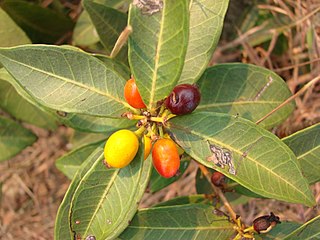
Eugenia calycina, also known as savannah cherry, field cherry, Jabuti cherry, Grao de galo, cerejinha, cereja de cerrado, pitanga-vermelha, red pitanga, pitanga cherry of cerrado, and ca-ajaboti, is a flowering shrub in the family Myrtaceae.

Symphyotrichum potosinum is a species of flowering plant in the family Asteraceae native to Mexico and the U.S. state of Arizona. Commonly known as Santa Rita Mountain aster, it is a perennial, herbaceous plant that may reach heights of 15 to 45 centimeters.

Symphyotrichum molle is a species of flowering plant in the aster family (Asteraceae) endemic to the Bighorn Mountains of Montana and Wyoming in the United States. Commonly known as soft aster, it is a perennial, herbaceous plant that ranges from 30 to 60 centimeters in height.
Oxyceros longiflorus is a shrub in the gardenia family (Rubiaceae) found in rainforests of northern South America. It is most noteworthy for its tubular flowers which can be up to 13 inches in length while not over one-twelfth inch in diameter, a 160 fold ratio of length to width, the greatest such ratio found among dry land (non-aquatic) plants. It is pollinated by a sphinx moth, possibly Amphimoea walkeri (Sphingidae) which has a 28 centimeter tongue or proboscis.
Chisocheton polyandrus, of the Mahogany Family (Meliaceae), is a species of pachycaulous, unbranched trees variously called "palmoids", "maypole trees" or "Corner Model Trees" occurring among several families of unrelated trees. C. polyandrus is native to Borneo, and grows up to a height of 49 feet in height, and may have small buttress roots or even prop roots. It is topped by a tight circle of indeterminate, once-pinnate leaves up to 5.5 feet in length, which may eventually have up to fourteen pairs of leaflets, acquired one pair at a time over a period of several months or years, each leaflet measuring up to 17 inches long by 5.5 inches in width. In mature leaves the oldest pair may die when a new pair is formed. The unbranched inflorescences are up to 6.5 feet long with the flowers occupying just the last foot or so, eventually hanging straight down as the weight of the fruit increases. The flowers are tubular, one to 1.25 inches in length. Petals 5 or 6, white with red blush and having up to 14 stamens. The fruit has three seeds, each covered with a red aril.
Gunnera magnifica, commonly called hoja de pantano, is a large herbaceous shrub or tree-like plant native to the montane rainforests of the Colombian Andes in Caldas Province. It can grow as high as 4.7 meters The lower trunk is decumbent and rhizomatous, while the upper trunk is upright and palm-like. This pachycaulous trunk is up to 40 centimeters thick. At the top is a rosette of huge leaves, the blade, or lamina of which is up to 115 cm long by up to 184 cm in width. The stalk, or petiole is 2.4 meters in length and 8 to 10 cm in thickness. These huge leaves emerge from a bud up to two feet long by up to 16 inches wide; the largest leaf bud of any known plant. The panicle of red, dimerous flowers is up to 2.3 meters in height. The bud scales covering the terminal bud are up to 39 cm in length by up to 7.5 cm wide, the largest of any known plant.
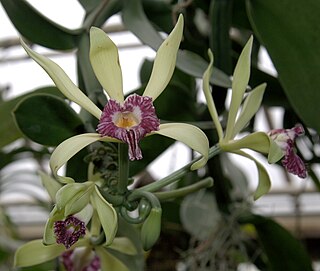
Vanilla imperialis is an orchid found from Sierra Leone eastward to Ethiopia and southward to Tanzania and Angola. It is a root-climbing vine to about 65 feet in height, with a root emerging just above each leaf. Although not as tall as the common vanilla, it is up to a full inch in thickness; the most massive Vanilla species, and the largest of all African orchids. The inflorescence is an unbranched raceme up to six inches long. The flowers are six inches wide with the white or yellow petals and sepals three inches (8 cm) long by 0.75 inch (1.8 cm) in width. The labellum is 2.5 inches in length with the far end flared and pink or purple. Most of the labellum is fused to the column, forming a tube. Each flower is open for at least two days( Chambers says seven days).














